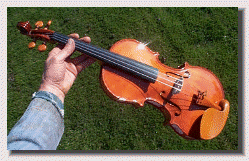Using classical music to break in violins....
(Or how to turn your violin into a speaker....)
...Most people will say that a good violin's tone should improve with extensive playing over a period of years. I have read that especially the low tones (notes) develop over time (hopefully). I have also heard the comment that 'violinists hate to play new instruments'. I imagine this is because there is so much yet to be done to most new instruments to make them acceptable professionally.
... How does one speed up time? How can I discover what the sound potential for a particular violin will be? I wonder about these kind of things; and being 69 years old already I know my time on the Lord's good Earth is limited. I find that prayer for ideas is helpful and this idea came to me: ...Why not make the violin into a sterio speaker so that it plays classical music 24 hours a day? This would expose the wood to the varying frequencies of an orchestra and perhaps loosen up the wood fibers (or what ever needs to happen) for tone to develop.
... My idea was to use a fully strung up, well set up instrument that already played well and expose it to this constant sound in as natural a manner as possible. It seemed that putting the sound into the top of the bridge (just like the bowed strings) would be the most likely method, so...
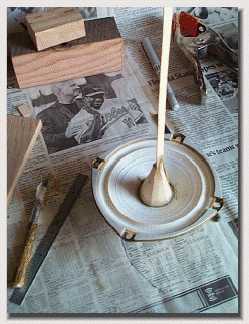
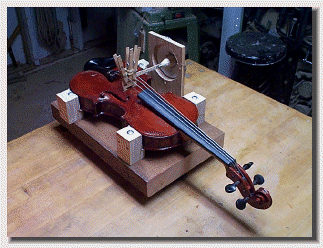
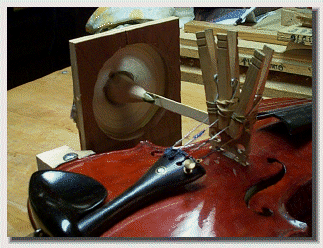
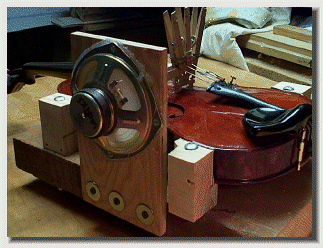
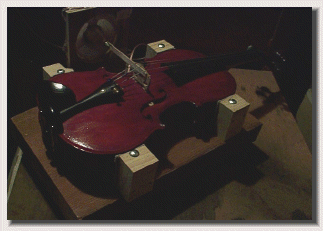
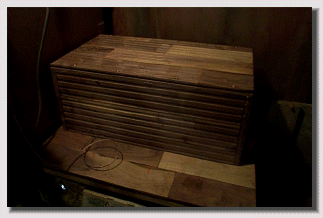
...First, I selected a 5 1/4", full range auto speaker made by Radio Shack, Catalog # 40-1354A capable of handling 40 watts of power with 10 Oz. magnet.
In order to transmit the motion of the speaker to the violin bridge, I drew a cone section on a piece of manila-folder paper, cut out and glued the overlap joint with bottled hide glue. To attach the paper cone to the center of the speaker I spread a two part epoxy mixture on the joint and let the joint cure.
...Then I cut out a piece of violin rib stock (0.040" thick maple wood) and cutting a slot into the top of my new paper cone, I glued it in place with violin making hide glue (hot water mix) and let it dry in line with the speaker centerline.
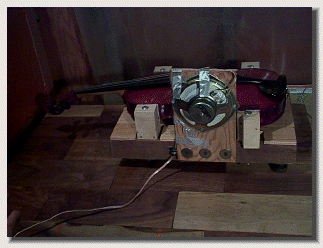
...Here I have mounted the speaker on a piece of 1/2" plywood which is securely screwed to the side of the mounting base board.
...The rib stock is glued to the back side of the top of the bridge with bottled hide glue with a 1/2" strip of manila folder paper between (to allow cutting the joint when test run is complete; just scrape the remains of the paper off the back side of the bridge and it should be back to original playing condition.)
...Next the speaker plate is positioned so that the wood extension naturally falls just against the back side of the top part of the bridge. The speaker plate is then drilled and firmly screwed to the base board. The wood strip coming from the speaker cone is then glued to the back side of the bridge with bottled hide glue and a piece of brown paper between. Here clothes-pins serve as clamps until the glue dries overnight.
...Remove clothes pin clamps when the glue has dried.
...The speaker wire from the sterio is soldered to the speaker and plugged in to the sterio...
...At this stage you will notice that I have lined the top surface of the support board with some thin hardwood flooring boards which I have glued and nailed on securely. This is to serve as an important sound reflector.
...The suppport base is a sheet of plywood with tongue and groove walnut flooring glued and nailed down (the smooth side up for best sound reflection).
...Now the last part is a bottomless box cover made of 3/4" walnut (or other hardwood) flooring, with the smooth side turned in toward the violin. This can be lifted off when needed.
...The purpose of the sound box is to reflect the sound that the violin generates back to amplify the vibrations of the body that are producing the sound already.
...The sound goes into the body of the violin through the bridge (just as normal violin tones would, through the vibrating of the bow strings) and the body of the violin {which is really a wooden speaker} amplifies the sound by vibrating and sending the sound to the surrounding air. When the sound reaches the hardwood which surrounds it, it is reflected with 95% effeciency and full spectrum tonal range. As this sound reaches the vibrating violin wood which just generated the sound, it is absorbed again by the wood and thus reinforces the vibration of the wood... which is the point of this exercise!
...As I write this first installment, (11/27/2005) the violin has been acting as the main speaker for my workshop and been on 24 hours a day for nearing 30 days. I have my sterio turned up to maximum safe power all the time for maximum effect. It is powerful enough that I can hear all types of classical music clearly through the wooden cover so that I normally do not turn on any of the other seven regular sterio speaker units that are scattered throughout my workshop. (I rebuild antique auto parts for a living, sometimes making a bit of noise), and that in past times would all have been on (not at full volume, however).
...High notes are accurately reporduced, and over the weeks, the midrange notes are much clearer than at first (still not quite as full and clear as a modern speaker cabinet with tweeters, mid-range and bass woofer speakers) but more clear than at first.
...At first the low notes (low cello, double bass, basson) were hardly audible, now after 3 1/2 weeks that are heard clearly but perhaps only with 1/2 the full speaker richness and power.
...I really enjoy listening to a good piano concerto on my violin or even opera! It is surprising how much music our violins would amplify if given a chance.
...Stay tuned for playing impressions in a week or so....
12/01/2005 report on first test:
...My opus # 14 violin was "played" in this manner at full (safe) volume 24 hours a day continually for 30 days. I then removed the violin and had my violin instructor Ron Kilde play it for me and give me his impressions. {Ron is very good at discovering the capability of in instrument, as well as all its flaws in a very short period of playing.} Ron commented that the high notes (upper 'e' string) played unusually easily and clear..."you do not have to force them at all". The lower registar is good but not wonderful (this violin never had a strong lower tonal color) but perhaps better than before.
...I then immediately installed my Opus # 18 violin in its place and it being "played" now 24/7.
...This particular violin does already have a good full range of tonal color so it is a worthy subject.... will keep you posted.
...(I will mention that it is a 'loud' speaker and the sound carries well throughout my auto parts rebuilding workshop, and it is really fun to hear classical music through my violin speaker!)
Results after 9 weeks of playin-in: the tone is richer and generally improved.
...Violin speaker in operation.
... then installed my opus # 06 violin in the sound box as my shop speaker. It was ' played' for eight weeks and afterwards it never sounded better. The sound carries well and is richer and more pleasing than before.
____________________________________
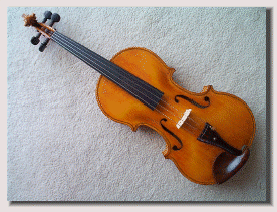
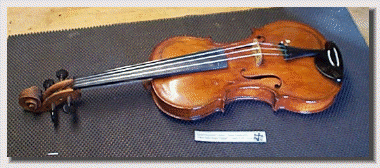
...Beginning April 1st, I installed my then latest completed violin, Opus # 19 in the sound box as my shop speaker. At five weeks (24 hours per day and on 'loud' setting of sterio) I notice that the volume/ projection is more than when first installed. Unless my workshop is noisy, I can listen to music all over my shop with the hardwood reflective cover in place with just this one 'speaker'. This violin already was noted as having superior power and projection before this step!
... After two full months at full volume, I removed this violin and my instructor played it with his regular Cascade Baking Company Saturday trio. He told my wife and I that he thought it was more powerful than his 1760 Italian violin he regularly plays (and he always claimed that his violin was the most powerful he had ever played).
(modified 8/2017)
Page AA_21
...Conclusions (2014): I think that most changes to a violin that contribute to its tonal development over time, are due to changes to the external parts and adjustments over time by highly qualifies experts, each of which makes an improvement. I believe these same adjustments can be made with the Tap Tone Technology approach you can read about in another area of this web site.....









